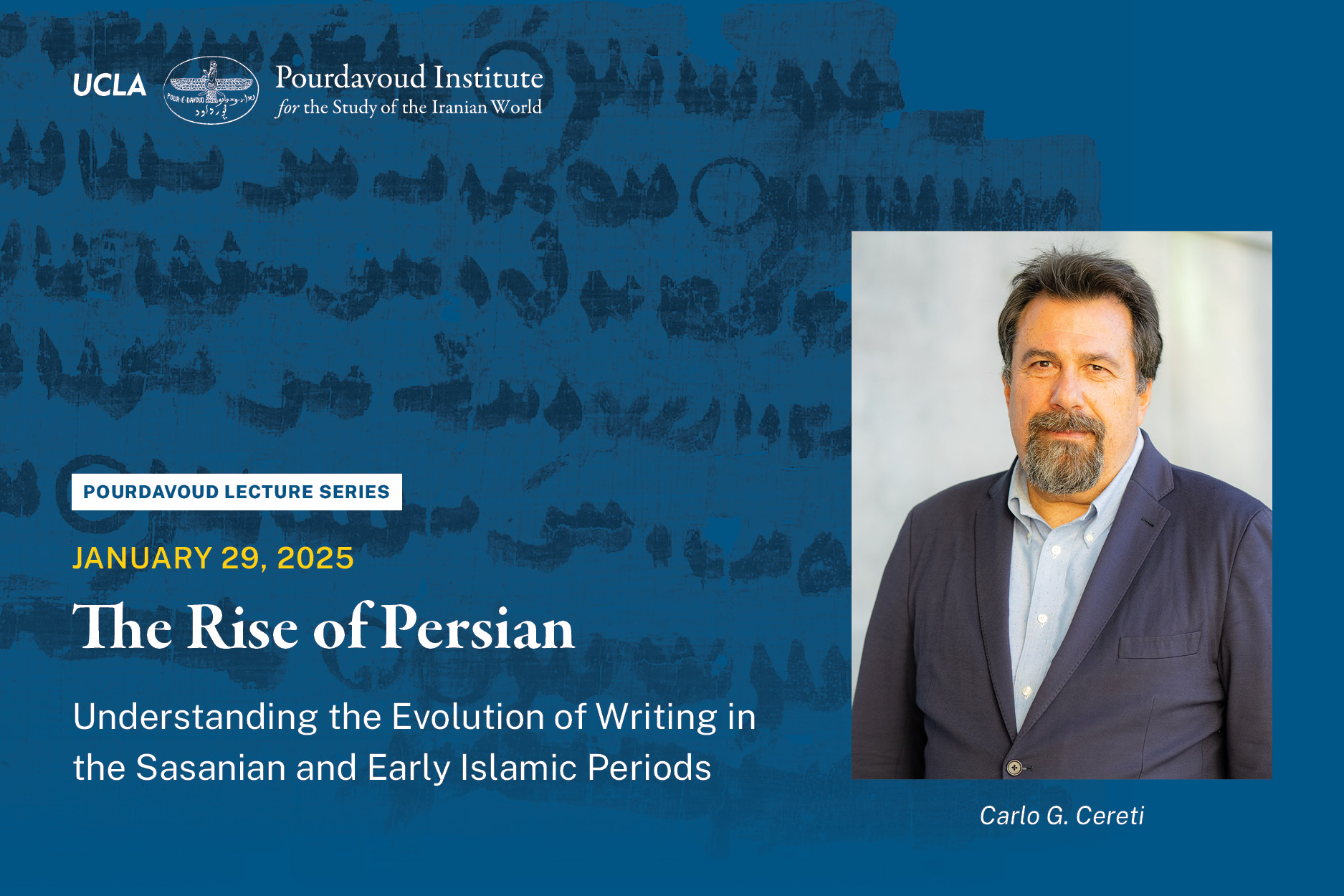
- This event has passed.
Pourdavoud Lecture Series: Carlo Cereti

The Rise of Persian: Understanding the Evolution of Writing in the Sasanian and Early Islamic Periods
This talk explores the evolution of writing during the Sasanian and early Islamic periods, shedding light on the long-term process that led to Persian becoming the lingua franca in Western and Central Asia from Iran to the borders of China. With the groundwork laid by pioneering scholars, we now have a stronger foundation for reading and understanding Middle Persian documents in their many forms. As Bernhard of Chartres observed, “we are but dwarves on the shoulders of giants,” benefiting from the invaluable contributions of previous generations.
Our understanding of Middle Persian script has progressed in many key areas ranging from 3rd century royal inscriptions to the legends found on coins and gems, and the wider array of secular texts written in ink on various materials. These include legal and commercial texts, letters, ostraca, and dipinti found on walls and stuccos. Notable examples include the dipinti from Dura Europos (3rd century CE), Pahlavi papyri from the Sasanian occupation of Egypt (7th century), and parchments from the Iranian highlands (7th century). Additional comparable texts were found in the Indian subcontintent and range from the Quilon Copper Plates (9th century), to Parsi inscriptions in the Kanheri caves close to Mumbai (11thcentury) and to Nestorian crosses in Chennai and Kerala.
While substantial evidence exists from the early and late Sasanian periods, a gap persists in our record from the central Sasanian centuries. This may be due to limited archaeological investigation in major Sasanian cities, though sociolinguistic shifts—perhaps after the Mazdakite movement disrupted the social order—may also have influenced the spread of writing. This analysis aligns with the scholarly interests of Ehsan Yarshater, who offered profound insights into Iranian National History, and invites further interdisciplinary inquiry to fully understand Persia’s enduring impact on the Islamic world.
About the Speaker
 Carlo G. Cereti joined the University of California in 2024, serving as Endowed Ferdowsi Chair in Zoroastrian Studies and Prof. of Classics and Religions at UCI. He has served since 2000 as Full Professor of Iranian Studies at Sapienza University of Rome, Dept. of Ancient World Studies, from 2009 to 2017 he acted as Cultural Counsellor at the Embassy of Italy in Tehran.. His earliest research work focused on the history of the Zoroastrian Parsi community in India, an intellectual interest that continued throughout his academic career, though in time his main research field shifted to Middle Iranian Languages and Literatures and more specifically to the study of Zoroastrian literature in Middle Persian. His interest in the medieval and modern history of the Zoroastrian community, combined with an intimate knowledge of Zoroastrian Middle Persian literature and more of Sasanian and post-Sasanian written culture led him to prepare critical editions of Middle Persian texts such as the Zand ī Wahman Yasn and many chapters of the Bundahišn, as well as a work of synthesis on the Pahlavi tradition (La Letteratura Pahlavi) From 2006 onwards he has intensively worked on epigraphic Middle Persian, with a focus on Narseh’s Paikuli inscription and on other epigraphic texts, including seals and sealings as well as ostraca and documents mainly dating to the late Sasanian and early Islamic periods. This line of research has led him in recent years to dedicate an increasing amount of time to analyzing the written tradition of Sasanian and early Islamic Iran, studying all different classes of written materials to analyze the phenomenon of literacy in its entirety and complexity.
Carlo G. Cereti joined the University of California in 2024, serving as Endowed Ferdowsi Chair in Zoroastrian Studies and Prof. of Classics and Religions at UCI. He has served since 2000 as Full Professor of Iranian Studies at Sapienza University of Rome, Dept. of Ancient World Studies, from 2009 to 2017 he acted as Cultural Counsellor at the Embassy of Italy in Tehran.. His earliest research work focused on the history of the Zoroastrian Parsi community in India, an intellectual interest that continued throughout his academic career, though in time his main research field shifted to Middle Iranian Languages and Literatures and more specifically to the study of Zoroastrian literature in Middle Persian. His interest in the medieval and modern history of the Zoroastrian community, combined with an intimate knowledge of Zoroastrian Middle Persian literature and more of Sasanian and post-Sasanian written culture led him to prepare critical editions of Middle Persian texts such as the Zand ī Wahman Yasn and many chapters of the Bundahišn, as well as a work of synthesis on the Pahlavi tradition (La Letteratura Pahlavi) From 2006 onwards he has intensively worked on epigraphic Middle Persian, with a focus on Narseh’s Paikuli inscription and on other epigraphic texts, including seals and sealings as well as ostraca and documents mainly dating to the late Sasanian and early Islamic periods. This line of research has led him in recent years to dedicate an increasing amount of time to analyzing the written tradition of Sasanian and early Islamic Iran, studying all different classes of written materials to analyze the phenomenon of literacy in its entirety and complexity.
Click here to register for the event.

